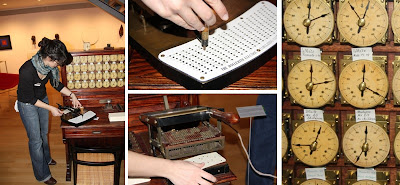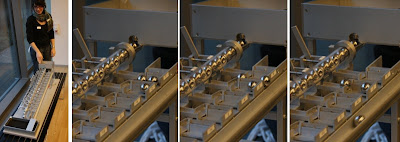Currently we have an assignment in our Pervasive Computing class that asks students to design and develop a system where actions are associated with artifacts. Technically students should develop a web based solution using RFID. Apropos RFID, … if you look for a good introduction on RFID read Roy Want’s IEEE Pervasive Magazin paper [1].
 We use the hardware from http://nabaztag.com/ (Ztamp:s and Mir:ror) as the focus is on the concept and application and not on the underlying technology. To ease development Florian and Ali have developed a little system that offers WebCallBacks (students can register a URL and that is called when a tag is read).
We use the hardware from http://nabaztag.com/ (Ztamp:s and Mir:ror) as the focus is on the concept and application and not on the underlying technology. To ease development Florian and Ali have developed a little system that offers WebCallBacks (students can register a URL and that is called when a tag is read).
Linking by tagging of objects has been well explored, e.g. [2] and [3], and I think it is about time that this technologies will make an impact in the consumer market – the technology gets cheap enough now (and perhaps one of our students has a great idea).
 Some years back (in the last millennium) a company tried to push linking of paper adverts and digital content with the CueCat (http://en.wikipedia.org/wiki/CueCat) – I was impressed and inspired at that time but in my view it had two major weaknesses: (1) technically too early and (2) encoding of serial numbers instead of URLs. The RadioShack catalog and the Wired Magazine that included codes showed the potential – but it was too cumbersome as it was restricted to the PC …
Some years back (in the last millennium) a company tried to push linking of paper adverts and digital content with the CueCat (http://en.wikipedia.org/wiki/CueCat) – I was impressed and inspired at that time but in my view it had two major weaknesses: (1) technically too early and (2) encoding of serial numbers instead of URLs. The RadioShack catalog and the Wired Magazine that included codes showed the potential – but it was too cumbersome as it was restricted to the PC …
We did some work on the topic, too around that time – at RFID reader integrated in a glove – which resulted in a Poster at ISWC [4] and a patent [5].
[1] Want, R. 2006. An Introduction to RFID Technology. IEEE Pervasive Computing 5, 1 (Jan. 2006), 25. DOI= http://dx.doi.org/10.1109/MPRV.2006.2
[2] Harrison, B. L., Fishkin, K. P., Gujar, A., Portnov, D., and Want, R. 1999. Bridging physical and virtual worlds with tagged documents, objects and locations. In CHI ’99 Extended Abstracts on Human Factors in Computing Systems (Pittsburgh, Pennsylvania, May 15 – 20, 1999). CHI ’99. ACM, New York, NY, 29-30. DOI= http://doi.acm.org/10.1145/632716.632738
[3] Ljungstrand, P. and Holmquist, L. E. 1999. WebStickers: using physical objects as WWW bookmarks. In CHI ’99 Extended Abstracts on Human Factors in Computing Systems (Pittsburgh, Pennsylvania, May 15 – 20, 1999). CHI ’99. ACM, New York, NY, 332-333. DOI= http://doi.acm.org/10.1145/632716.632916
[4] Schmidt, A., Gellersen, H., and Merz, C. 2000. Enabling Implicit Human Computer Interaction: A Wearable RFID-Tag Reader. In Proceedings of the 4th IEEE international Symposium on Wearable Computers (October 18 – 21, 2000). ISWC. IEEE Computer Society, Washington, DC, 193. (Poster as large PNG)
[5] US Patent 6614351 – Computerized system for automatically monitoring processing of objects. September 2, 2003. http://www.patentstorm.us/patents/6614351/description.html












